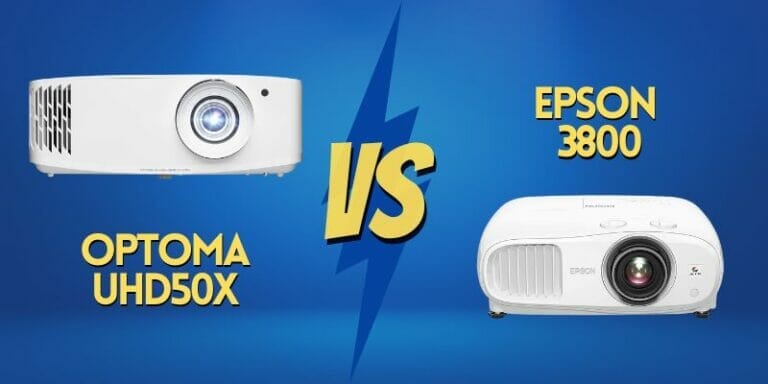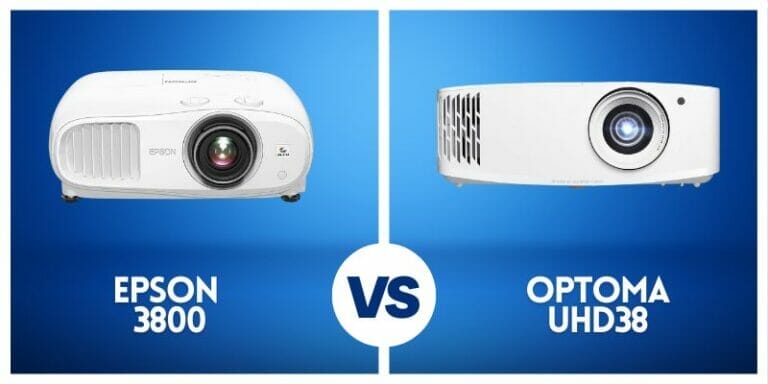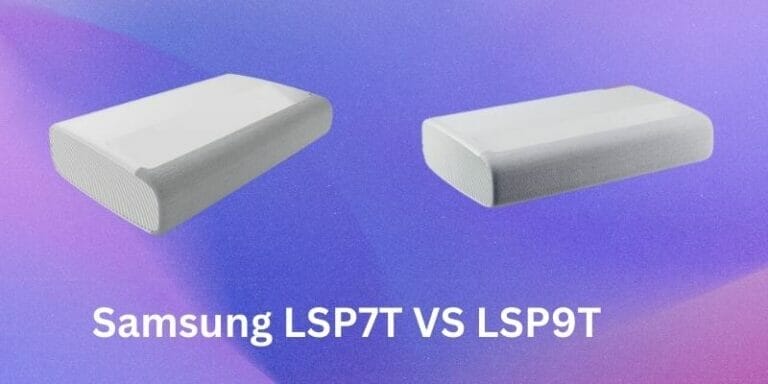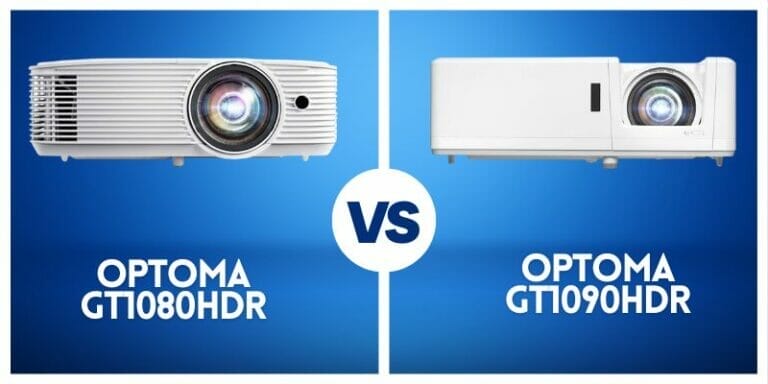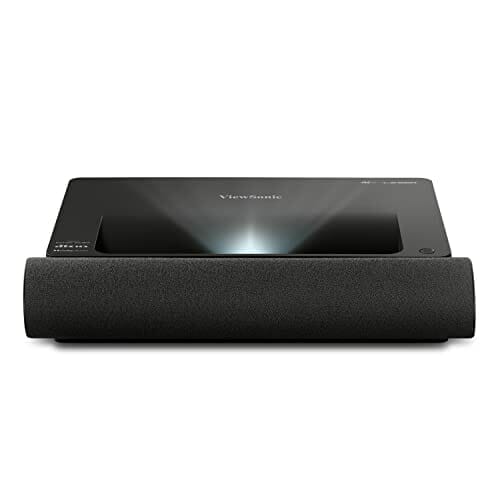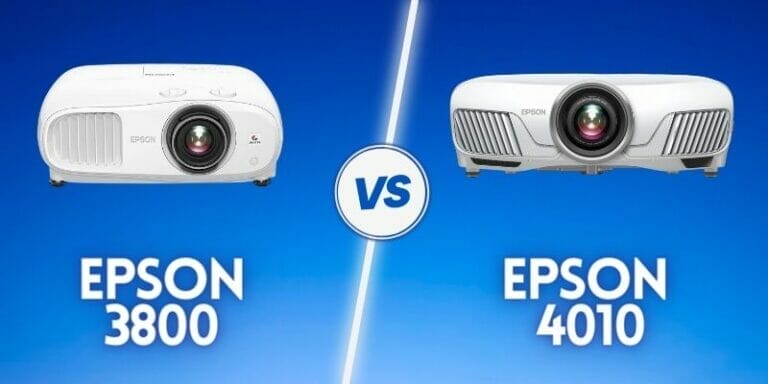BENQ HT2050A VS Epson 2250
Are you looking for a good quality home-theater device but don’t have a lot of budget? With so many low-cost projectors out there, it can be hard to figure out which one is best for you.
Buying a home theater isn’t necessarily a cheap option. And if the price gets compromised, then so does the quality. I am here to review the top two projectors that are affordable in price and won’t compromise on quality.
Today I have selected the BenQ HT2020A and the Epson 2250 because they are both offering amazing quality for just under your budget.
Let’s quickly compare these two projectors so that you know which one is more suitable for your specific needs.
Before we begin this blog, let me just quickly tell you the main difference between these two projectors.
So, the main difference between the BenQ HT2020A and the Epson 2250 is the processing chips that they use. The Epson 2250 uses 3 LCD technology, while the BenQ HT2050A uses a color wheel.
Now let’s do a quick side-by-side comparison of the BenQ HT2020A and the Epson 2250.
Quick Comparison BENQ HT2050A VS Epson 2250
Similarities
As you might have noticed already, both these projectors come in the affordable price range. Both of them offer the same resolution, which is the number of pixels on the screen.
The screen size they can project is also pretty much the same.
In terms of design, they both come in white color and look almost the same as well.
Both offer vertical and horizontal lens shift and keystone correction options.
Differences
Aside from the processor chip difference, the other main difference between these two models is that the Epson 2250 comes with smart TV features, while the BenQ HT2050A doesn’t.
Another key difference is that the BenQ model has an extra HDMI port, whereas the Epson 2250 has only one.
Lower input lag in the BenQ model makes it a better option for gaming, and the lower throw ratio also gives it another edge over the Epson 2250.
Installation and setup
The BenQ HT2050A and the Epson 2250 are both very easy to set up. They both have 2D keystone correction along with zoom and vertical lens shifts.
The BenQ HT2050A has a shorter throw distance, needing about 8-10 feet for a 100” screen. So while it does need a decently large space, it can certainly be accommodated in slightly smaller areas.
A detailed Review of BenQ HT2050A
Specifications
- Resolution: 1920×1080
- Brightness: 2,200 lumens
- Contrast ratio: 15,000:1
- Input lag: 16ms
- Throw distance: 4.4′ – 25.1′
- Screen size: 40″ – 300″
- Built-in mono 10W speaker
The BenQ HT2020A is a 1080p projector with amazing color accuracy, 2,200 lumens brightness, super low input lag for gamers, and a good throw ratio for smaller rooms.
It comes with a dial for focus, zoom, and vertical lens shift, so you get the perfect picture no matter where you put it in your room.
The design also comes with adjustable feet at the bottom and a quick-release foot at the front.
The BenQ HT2050A has a 6X RGB RGB color wheel, 3D support, and a great throw ratio.
Viewers who are sensitive to the rainbow effect may notice it when they turn their heads quickly, but it isn’t very noticeable if you don’t pay attention to it.
Because it can project a 100-inch image from about 8 feet away, BenQ does refer to this projector as an Ultra Show Throw projector. Obviously, this isn’t a real short-throw projector, but it does come pretty close!
Talking about the picture quality, the BenQ also produces a clear image with good brightness and great color accuracy. The 10W mono speaker produces clear sounds, and it does get surprisingly loud for an internal speaker.
Now let’s talk about some of its special features. It comes with horizontal keystone correction, which wasn’t in the previous 2050 model. This will allow you to position the projector off to the side of the room if you need to.
The other special feature is the much lower input lag. You won’t have to compromise image quality for a great input lag in this model!
An added bonus is that the BenQ HT2050A comes with a 3-year warranty, as compared to the 1-year warranty of the HT2050.
Pros
- Wide color gamut (96% of Rec.709 spectrum)
- More compact design
- Extra HDMI port
- 3D support (with external glasses)
- Advanced Gaming Mode
- The speaker has good sound quality
- Very short throw range, good for smaller rooms
Cons
- Has rainbow effect
- No built-in streaming capability
- Lower brightness
A detailed review of Epson 2250
Specifications
- Resolution: 1920×1080
- Brightness: 2,700 lumens
- Contrast ratio: 70,000:1
- Input lag: 28ms
- Throw distance: 4.7′ – 29.0′
- Screen size: 30″ – 300″
- Built-in mono 10W speaker
The Epson 2250 uses a 3 LCD technology, which means you will be getting the full range of colors for every frame. So you’re not going to be seeing the rainbow effect with this projector. The Dynamic Iris technology maximizes the sharpness of the image, with no flicking, hot spots, or other image issues.
It also comes with vertical plus horizontal lens shift and keystone adjustments to make sure you get an accurate image. You can project a 120-inch accurate image from just 18 feet away!
The 2250 does include Android TV, along with a 10W speaker. The speaker isn’t really all that great, you so will definitely want to hook this up to a proper speaker system.
You do get an amazing contrast ratio, along with 2700 lumens of brightness. Effectively, that means you will probably need to close the curtains on a very bright day. However, it doesn’t need to be a particularly darker room in order for you to get a projected image.
And finally, you will get some pretty neat image enhancement options from within the menu software, and you also get Frame Interpolation as well.
Overall, this projector is ideal for those who want a projector with sharper image quality and has smart TV features.
Pros
- Very easy to set up
- Includes Smart TV option
- Lens shift and keystone correction
- 3LCD, so no rainbow effect
- Frame interpolation and other image enhancement features
- Sharper image with brighter colors
- Good for gaming as well.
Cons
- The speaker doesn’t produce a good enough sound quality
- Only one HDMI port
Final Verdict
While both these projectors offer amazing value for money, the Epson version has a slightly larger edge over the BenQ model. This is mostly because it is offering smart TV features in the device.
The Android TV interface of the Epson 2250 lets you stream content directly to the projector, no content sources are required. It also works with Google Assistant for voice control and smart home integration.
However, which projector you choose to buy largely depends on what features you want in your home cinema device. If you are looking for excellent picture quality with no rainbow effect and built-in smart TV option, go for Epson 2250.
But if you have a smaller room and need something with a shorter throw range, good input lag for gaming, and 3D support, I suggest you go for BenQ HT2050A.
Frequently Asked Questions
Is Epson 2250 worth it?
Epson 2250 is certainly a projector that is worth buying. It is very easy to set up, offers smart TV features, has sharp picture quality with no rainbow effect, good brightness, and 3D projection capabilities.
Is the BenQ HT2050A wireless?
The BenQ HT2050A doesn’t have any built-in wireless capability. But it does have a wide range of wired input options. With the two HDMI ports, you can connect an Amazon Fire Stick or any other smart TV stick to enjoy television on this projector.
Does Epson 2250 have HDMI ARC?
No. Unfortunately, the Epson 2250 doesn’t support HDMI ARC.
Does Epson 2250 support 4K?
Although the Epson 2250 is not a true 4K projector, it can convert and accept any content up to 4K, for a full High Definition picture


